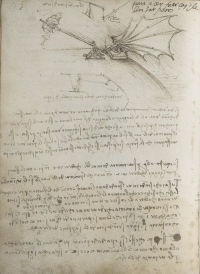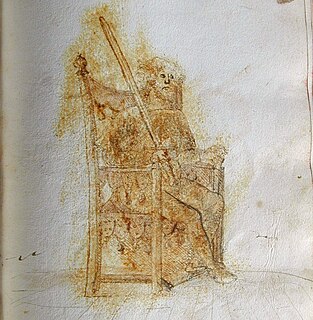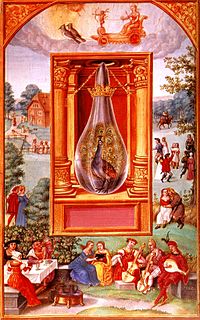 W
WAn anonymous author known as the Anonimo Gaddiano, Anonimo Magliabechiano, or Anonimo Fiorentino is the author of the Codice Magliabechiano or Magliabechiano, a manuscript with 128 pages of text, probably from the 1530s and 1540s, and now in the Central National Library of Florence. It includes brief biographies and notes on the works of Italian artists, mainly those active in Florence during the Middle Ages. Among several other suggestions, the anonymous author has been suggested to be Bernardo Vecchietti (1514–1590), a politician of the court of Cosimo I. The author clearly had intimate access to the Medici court.
 W
WThe Apel Codex is a German manuscript which dates from about the year 1500, providing an important source for 15th and 16th century polyphonic music. The works in the manuscript were collected by Nikolaus Apel from about 1490 to 1504. They consist of 172 pieces in 260 folios, mainly liturgical music by German and northern European composers, including examples of the low contra-tenor scoring which became a specialty of German music of the period.
 W
WThe Asloan Manuscript is an anthology of Scots prose and poetry dating to the early sixteenth century. It was compiled by the Edinburgh notary John Asloan.
 W
WThe Book of the Dean of Lismore is a famous Scottish manuscript, compiled in eastern Perthshire in the first half of the 16th century. The chief compiler, after whom it is named, was James MacGregor, vicar of Fortingall and titular Dean of Lismore Cathedral, although there are other probable scribes, including his brother Donnchadh and William Drummond, curate of Fortingall. It should not be confused with the similarly named Book of Lismore, an Irish manuscript from the early 15th century.
 W
WThomas Markaunt was a Fellow and benefactor of Corpus Christi College, Cambridge University. He is best known for his sizeable bequest of seventy-five books to Corpus Christi library, which were lent out to the student body in a formal academic system of 'electio'. However he is also of note for his extensive compilation of early University records, known as "Markaunt's book", which gained him a historical reputation as an antiquarian. While the majority of his original bequest has not survived the centuries, the extensive electio records and surviving books have been the subject of much study.
 W
WThe Cancionero de Palacio, or Cancionero Musical de Palacio (CMP), also known as Cancionero de Barbieri, is a Spanish manuscript of Renaissance music. The works in it were compiled during a time span of around 40 years, from the mid-1470s until the beginning of the 16th century, approximately coinciding with the reign of the Catholic Monarchs.
 W
WCatalogue of the Archbishops of Gniezno is an illuminated manuscript by Jan Długosz. It was illustrated by Stanisław Samostrzelnik.
 W
WThe Codex Kingsborough, also known as the Codex Tepetlaoztoc, is a 16th-century Mesoamerican pictorial manuscript, detailing the history of Tepetlaoztoc and the abuse of the encomenderos who took control after the Spanish conquest of Mexico. It is currently in the collections of the British Museum.
 W
WCodex on the Flight of Birds is a relatively short codex from c. 1505 by Leonardo da Vinci. It comprises 18 folios and measures 21 × 15 centimetres. Now held at the Royal Library of Turin, the codex begins with an examination of the flight behavior of birds and proposes mechanisms for flight by machines. Leonardo constructed a number of these machines, and attempted to launch them from a hill near Florence. However, his efforts failed.
 W
WThe Códice Casanatense, its popular Portuguese title, or the Codex Casanatense 1889, is a set of 16th century Portuguese illustrations, which depict peoples and cultures whom the Portuguese frequently had contact with around the Indian and Pacific oceans. It is now kept at the Biblioteca Casanatense in Rome, with the official designation of Album di disegni, illustranti usi e costumi dei popoli d'Asia e d'Africa con brevi dichiarazioni in lingua portoghese.
 W
WThe de Landa alphabet is the correspondence of Spanish letters and glyphs written in the pre-Columbian Maya script, which the 16th-century bishop of Yucatán, Diego de Landa recorded as part of his documentation of the Maya civilization. With the aid of two Maya informants familiar with the script, de Landa made an attempt to provide a transcribed "A, B, C" for the Maya script with the intent of providing a key to its decipherment and translation. Despite its inaccuracies, the information provided by him would much later prove to be crucial to the mid-20th century breakthrough in the decipherment of the Maya script, starting with the work of the Soviet epigrapher and Mayanist Yuri Knorozov.
 W
WDrexel 4180–4185 is a set of six manuscript partbooks copied in Gloucester, England, containing primarily vocal music dating from approximately 1615-1625. Considered one of the most important sources for seventeenth century English secular song, the repertoire included represents a mixture of sacred and secular music, attesting to the partbooks' use for entertainment and pleasure, rather than for liturgical use.
 W
WThe Glasgow Fechtbuch is a combat manual of the German school of fencing, dated to 1505. Consisting of 105 folia, it combines the instructions of various masters of the 15th century who stood in the tradition of Johannes Liechtenauer, presumably based on a previous compilation made by fencing master Sigmund Schining ein Ringeck.
 W
WThe Goražde Psalter is a printed psalter published in 1521 in Church Slavonic of the Serbian recension. It is counted among the better accomplishments of early Serb printers. With its 352 leaves, it is the largest of the three books produced by the Goražde printing house—the first printing house in the territory of present-day Bosnia and Herzegovina. The production of the psalter was managed by Teodor Ljubavić, a hieromonk of the Mileševa Monastery.
 W
WThe Maitland Manuscripts are an important source for the Scots literature of the Fifteenth and Sixteenth Centuries. They contain texts of the work of the makars of the period and much material which is not attributed to any author.
 W
WThe Miroir or Glasse of the Synneful Soul is a manuscript book that was given to Catherine Parr by her stepdaughter, the future Elizabeth I of England in 1544, when Elizabeth was eleven years old. Elizabeth translated the poem from the French work Miroir de l'âme pécheresse by Marguerite de Navarre, into English prose and wrote the manuscript with her own hand, dedicating it with the words, "From Assherige, the last daye of the yeare of our Lord God 1544 ... To our most noble and vertuous Quene Katherin, Elizabeth her humble daughter wisheth perpetuall felicitie and everlasting joye," Elizabeth probably also embroidered the bookbinding. This book is now owned by the Bodleian Library.
 W
WNature Studies is an illustrated manuscript of the 16th century, which represents nature scenes. It was part of the collection of the Holy Roman Emperor Rudolph II.
 W
WThe Recueil d'Arras is a mid 16th century manuscript. Tentatively attributed to the Netherlandish artist Jacques Le Boucq, it comprises 293 paper folios, of which nrs 5–177, 179–293 and 271 contain 289 copies of drawn portraits of named historical people.
 W
WSplendor Solis is a version of the illuminated alchemical text attributed to Salomon Trismosin. This version dates from around 1582.
 W
WThe Título de Totonicapán, sometimes referred to as the Título de los Señores de Totonicapán is the name given to a Kʼicheʼ language document written around 1554 in Guatemala. The Título de Totonicapán is one of the two most important surviving colonial period Kʼicheʼ language documents, together with the Popol Vuh. The document contains history and legend of the Kʼicheʼ people from their mythical origins down to the reign of their most powerful king, Kʼiqʼab.
 W
WThe Topkapı Scroll is a Timurid dynasty pattern scroll in the collection of the Topkapı Palace museum.
 W
WUndang-Undang Melaka, also known as Hukum Kanun Melaka, Undang-Undang Darat Melaka and Risalah Hukum Kanun, was the legal code of Melaka Sultanate (1400-1511). It contains significant provisions that reaffirmed the primacy of Malay customary law or adat, while at the same time accommodating and assimilating Islamic principles. The legal code is believed originally compiled during the reign of Muhammad Shah (1424-1444), before it was continuously expanded and improved by the succeeding sultans. The Melaka system of justice as enshrined in the Undang-Undang Melaka was the first digest of laws, compiled in the Malay world. It became a legal resource for other major regional sultanates like Johor, Perak, Brunei, Pattani and Aceh, and has been regarded as the most important of Malay legal digests.